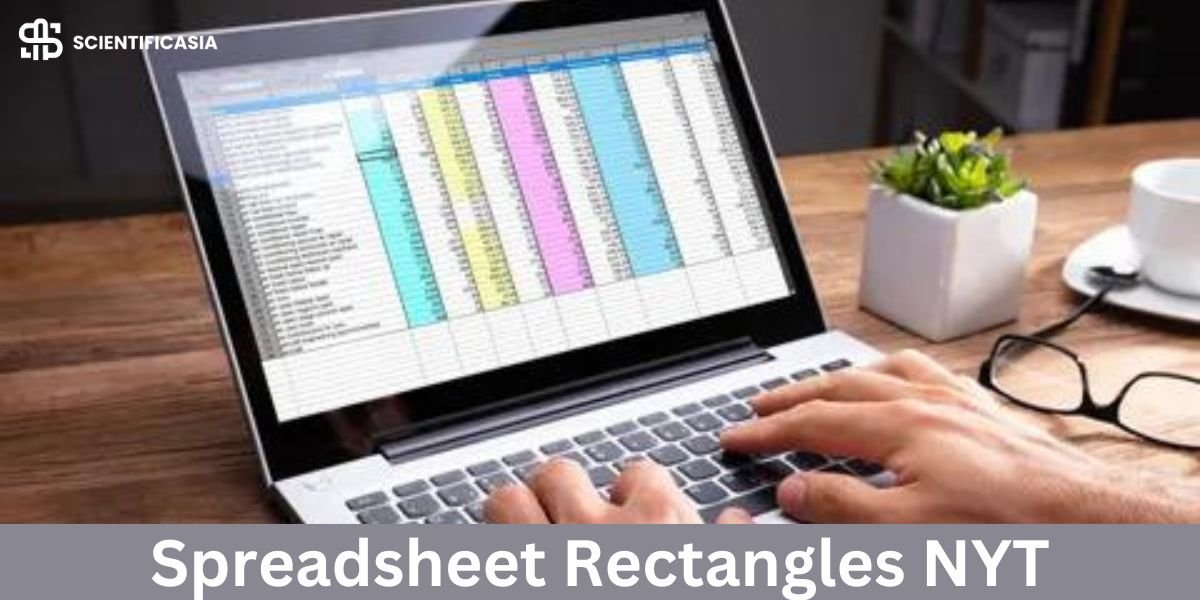Understanding Spreadsheet Rectangles NYT
A range of cells formed by defining the top-left and bottom-right corners of a spreadsheet is referred to as a spreadsheet rectangle. Anything from a single cell to a sizable block of cells spanning several rows and columns can be represented by these rectangles. To organize, manage, and analyze data on a spreadsheet, rectangles are necessary.
How spreadsheet rectangles NYT might enhance data management and organization Spreadsheet rectangles NYT provides an organized and aesthetically pleasing method of efficiently organizing data. Users can effortlessly divide the material into discrete portions by employing the rectangle format, which facilitates navigation and analysis. As a result of this better arrangement, data management procedures are improved since complicated information is presented more clearly and with less clutter.
Additionally, spreadsheet rectangles make it easy to sort and filter data according to particular standards, giving users speedy access to the information they require without having to trawl through superfluous details. Rectangle layout customization allows you to further improve the organization by adjusting the display to meet project requirements or personal preferences.
Exploring UVA Canvas: Enhancing Learning and Collaboration
Spreadsheet rectangles also make it easier to track changes over time since they give data trends a clear visual depiction. This tool is very helpful for tracking project progress and evaluating financial results.
Rectangles may appear a bit…unremarkable to those who have dabbled in spreadsheets, especially with the widely used Microsoft Excel. Spreadsheets are grids with rectangles on them, after all. However, there may be a more subtle connotation at work in the context of a recent New York Times piece (it’s hard to determine the precise application without access to the article itself).
Grenblis: A Comprehensive Guide
The following is a summary of the various interpretations:
1. Cell Selection
Rectangles in spreadsheets are mostly understood about cell selection. A rectangle that highlights the cells in question is created when you click and drag the mouse over certain cells. You can format (change the font size, color, etc.) the selected region, copy and paste the selected area, or insert data into all selected cells at once using this selection.
2. Ranges with names:
Spreadsheets enable tagging particular cell ranges (rectangles) with names. This facilitates referring to huge datasets or commonly used computations. For instance, you might label the range “SalesData” and use that name in calculations instead of constantly referring to cell B5:D12. It’s possible that the New York Times article covered the definition of these specified ranges using rectangles.
3. Graphs and Charts:
Spreadsheets provide a range of graph and charting choices for data visualization. When you choose data for a chart, those cells are often surrounded by a rectangle. It’s possible that the article explained how rectangles represent data selection in charts visually.
4. Formatting on Condition:
You can apply formatting adjustments to cells depending on certain criteria by using conditional formatting. A rectangular range of cells can be defined, and formatting rules can be set for those cells according to the data they contain. An exploration of the use of rectangles to specify the region for conditional formatting may have been the focus of the essay.
5. VBA and macros (not all spreadsheet programs support VBA):
Spreadsheets like Excel allow more experienced users to use VBA (Visual Basic for Applications) to build macros or automated functions. VBA can define named rectangles especially for usage in the macro, as well as alter and reference cell ranges using coordinates. It’s possible that the article explored a situation in which VBA coding uses rectangles.
Googles 25e Verjaardag: A Comprehensive Guide
Spreadsheet Rectangles NYT Applications in Data Organization
Rectangles on a spreadsheet are flexible tools that can be used in many different contexts to effectively organize data:
1. Organization of Data
Rectangles aid in the logical organization of data, simplifying its navigation and analysis. For example, multiple rectangles can stand for different datasets, like inventory levels, customer information, or sales figures.
2. Algorithms and Estimates
Calculations over several cells can be done efficiently by using ranges in formulas. Typical instances consist of:
- SUM: =SUM(A1:A10) to add values in a vertical range.
- AVERAGE: =AVERAGE(B1:B10) to calculate the mean of a range.
- IF: =IF(A1:A10 > 100, “High”, “Low”) for conditional checks across a range.
3. Verification of Data
By establishing validation criteria, rectangles can be utilized to enforce data integrity. For example, to ensure consistency and minimize errors, you can limit entries inside a range to particular formats or values.
4. Formatting Conditionally
Rectangles that have conditional formatting applied to them improve data display. For instance, you can use color scales to display performance data or highlight cells in a range according to their values.
5. Tables with pivots
To summarize and evaluate big datasets, pivot tables require rectangles. Pivot tables may dynamically produce insights, such as sales totals by region or product category, by choosing a range as the data source.
UTSA Canvas: Your Guide to the Roadrunner Learning Hub
Guidelines for Using Spreadsheet Rectangles to Organize Data
Take into account these basic strategies to optimize the advantages of utilizing rectangles in spreadsheets:
1. Conventions for Naming
Establish uniform and lucid naming guidelines for your ranges. This facilitates the handling and understanding of formulas, particularly in intricate spreadsheets. For example, instead of naming a range “A1,” name it “MonthlyExpenses.”
2. Ranges of Dynamics
To automatically adapt when data changes, use dynamic ranges. Formulas like OFFSET and INDEX, which update the range based on predetermined criteria, can be used to accomplish this.
3. Rules for Validating Data
To guarantee data quality, put data validation procedures into practice. To limit entries to particular forms, such as dates or numerical values inside a range, for instance, utilize custom formulas.
4. Record-keeping
Keep a record of the function and organization of rectangles in your spreadsheet. Described ranges, calculations, and any applicable validation criteria are all included in this. Effective documentation facilitates troubleshooting and improves teamwork.
5. Continual Examinations
Check your spreadsheet regularly to make sure rectangles are defined and utilized correctly. Look for calculation errors, out-of-date ranges, and inconsistent data entry.
Google Bard AI Login: A Comprehensive Guide
Improved Methods Using Spreadsheet Rectangles
Advanced methods can further improve data management capabilities for power users:
1. Formulas for arrays
Range-wide complicated calculations can be performed with array formulae. For weighted calculations, for instance, =SUM(A1:A10*B1:B10) multiplies similar values and sums the results.
2. Automation and Scripting
To automate activities using rectangles, use scripting languages such as Google Apps Script in Google Sheets or VBA (Visual Basic for Applications) in Excel. Scripts can help to automate time-consuming tasks like creating reports or cleansing data.
3. Combining Information from Outside Sources
Rectangles can be connected to external data sources like web APIs and databases. This makes it possible to integrate and update data in real time, making data management more dynamic and networked.
Determining the Precise Interpretation:
Unfortunately, it is impossible to determine the precise meaning of “spreadsheet rectangles” without knowing the full context of the New York Times story. Nonetheless, the aforementioned options offer a solid foundation for comprehending the diverse applications of rectangles in spreadsheet features.
To better understand, take a look at these actions:
- Search the article for any keywords or surrounding content that might point to the particular use case.
- To locate the complete context, search online for the article title or a pertinent excerpt.
- Look through your spreadsheet software’s help files for any features or functionalities that were covered in the article.
Rectangles are a useful tool in spreadsheets that can help you become a more adept and efficient user, which will make data management and analysis easier.
Case studies and company success narratives showcasing the use of spreadsheet rectangles
Let’s examine some actual cases of businesses utilizing spreadsheet rectangles to improve their operations. Spreadsheet rectangles were used by Company X, a well-known financial organization, to simplify their budgeting procedure. They were able to track costs and project future financial performance with ease by arranging data into neat, structured rectangles.
In another instance, the computer startup Company Y managed projects using spreadsheet rectangles. They made intricate spreadsheets with colored rectangles to efficiently keep track of assignments and due dates. This made it easier for them to manage several projects at once and guarantee on-time delivery.
Additionally, Company Z used spreadsheet rectangles’ collaborative features to facilitate effective teamwork. Teams may work together on intricate projects without missing a beat thanks to real-time updates and shared access to data inside rectangular cells.
These case studies demonstrate the adaptability and efficiency of spreadsheet rectangles across a range of sectors to enhance data management and organizing.
Rice Canvas: A Comprehensive Guide to Your Digital Classroom
In summary
Spreadsheet rectangles are a flexible and useful tool for efficiently arranging data in spreadsheets. You may optimize your data organization, boost accuracy, and simplify intricate computations by comprehending their uses and implementing best practices. Using rectangles will improve your spreadsheet skills and streamline your data management procedures, regardless of the complexity of the datasets you are working with, from simple lists to complex ones.
You may maximize spreadsheet rectangles by putting these tactics into practice, which will revolutionize your data management procedures and increase productivity all around.
Read More Blogs:
Siena Canvas: A Digital Hub for Learning
Envato Grammarly Canva package: A Design and Writing Dream Team
Emu Canvas: Revolutionizing Online Learning
UNT Canvas: Revolutionizing Education at the University of North Texas
FAQ’s
What is the focus of the article “Demystifying Spreadsheet Rectangles” by the New York Times (NYT)?
The purpose of this article is to help common users better understand and utilize spreadsheet rectangles by breaking down their many functions and intricacies. It covers a wide range of topics, from fundamental cell activities to more sophisticated characteristics.
Why are spreadsheets important in data management?
Spreadsheets are necessary for data organization, analysis, and visualization. They are an essential tool in business, finance, education, and many other disciplines because they offer a versatile platform for managing big datasets, carrying out calculations, and producing reports.
What are some common uses of spreadsheet rectangles?
Creating schedules, managing budgets, tracking spending, running statistical analysis, and producing graphs and charts are among the many uses. Rectangles on spreadsheets, also called cells, are essential to these jobs because they contain the formulae and data that make the spreadsheet work.












